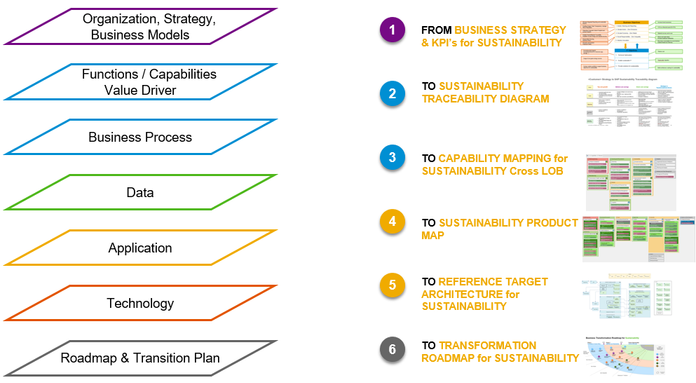
- SAP Community
- Groups
- Interest Groups
- Enterprise Architecture
- Blog Posts
- Enterprise Architecture for Sustainable Enterprise
- Subscribe to RSS Feed
- Mark as New
- Mark as Read
- Bookmark
- Subscribe
- Printer Friendly Page
- Report Inappropriate Content
Sustainability is one topic which is gaining momentum across all industries and every CxO is talking about it. There are different dimensions to this most relevant topic of today and future but if you are in the job to guide the large and strategic customers of SAP in defining their target application architecture and roadmap, then this is even more relevant to help them become intelligent and sustainable enterprise. Enterprise Architects role has become more relevant than ever in an organization to make it a sustainable enterprise
Sustainability is not new, and it has always been there. But why now? The key is to help the world run better and transforming the world via The 2030 Agenda for Sustainable Development, adopted by all United Nations Member States in 2015. This provides a shared blueprint for peace and prosperity for people and the planet, now and into the future. At its heart are the 17 Sustainable Development Goals (SDGs), which are an urgent call for action by all countries - developed and developing - in a global partnership
Organizations who care for this are spending lot of time and effort to identify the right priorities and select the right technology solutions to address this global challenge, and in other words also in pressure to implement these SDGs. One of the reasons is because the environment, health & safety (EHS) and overall sustainability related topics in an organization has shifted from cost driver and compliance priorities to a competitive advantage and differentiation from the competitors and for their customers. Enterprise architecture can help in achieving these SDG goals by mapping the business capabilities prioritized for sustainability to the best fit applications and deriving the transformation roadmap and the future state architecture
SAP’s focus on Sustainability is also aligned to SDG goals and you can find more in this link https://www.sap.com/about/company/our-values/purpose-and-sustainability.html . SAP’s goal is to chase zero for sustainability and Integrate sustainability data to business processes across all value chains to drive performance, new products, new markets. The chasing zero is across all industries and all end-to-end processes. Three zeroes are as follows:
- Zero Waste with Circular Economy - Contribute to a zero-waste world by incorporating circularity into supply chains
- Zero Emissions with Climate Action - Generate cost savings by transitioning from “Low to No” emissions
- Zero Inequality with Social Responsibility - Ensure zero incidents, accidents and harm to communities, people, and the environment
- Sustainability Steering and ESG Reporting - Mapping data to show impact with holistic reporting enabling sustainable business decisions
From an IT perspective, there are many architecture decisions which needs to be taken to reach the goal of Sustainable Enterprise. Some of the decisions are as follows:
- How do we determine the priorities for Sustainability to define the future state IT architecture?
- What are the target applications for the traditional EH&S areas such as Product Compliance and Environment, Health & Safety (EH&S) currently running in SAP ECC solution?
- What are the architecture options and product roadmap for next generation SAP Sustainability applications such as Product Footprint Management, SAP Responsible Design and Production, SAP Sustainability Control Tower?
- What are the options available for Specification Database (Spec Db)?
- What are the Architecture Options for the following solutions?
- Environment Health & Safety solution
- Product Compliance solution for discrete industry and process industry
- Incident management solution
- Environment Management solution
- Waste Management solution
- Substance Volume Tracking, Hazardous substances management, Dangerous goods management.
The above are some of the decisions to be discussed during the architecture sessions and this is no means an exhaustive list. E.g. Today customers have choice between implementing classic capabilities of SAP S/4HANA for Product Compliance or the new capabilities of SAP S/4HANA for Product Compliance. There are pros and cons of both the options
Enterprise Architecture Methodology, Content and Tool is an excellent way to address the above questions, which will help to define the business capability map for sustainability priorities, baseline target application architecture and roadmap for SAP Sustainability Applications. This will then be revisited, re-validated and incrementally updated based on the change events at the customer strategic plan and SAP Product Roadmap planning
Fig 1: (Sample) Enterprise Architecture methodology for Sustainability
Food for thought:
Sustainability is the next big priority for Digital Transformation. Sustainability is gaining fast momentum as the strategic topic for any organization and enterprise architecture will play an important role in making these organizations a sustainable enterprise.
Would be interested to know your thoughts, perspectives, and experiences on this important topic.
We will also have a closer on the capability mapping (Step 3) from the business architecture point of view and the key target application architecture (Step 5) for SAP Sustainability solutions in the upcoming blog series
You must be a registered user to add a comment. If you've already registered, sign in. Otherwise, register and sign in.
-
Application Architecture
23 -
Business Architecture
33 -
Data Architecture
19 -
Emerging Trends
19 -
Enterprise Architecture
53 -
Frameworks
19 -
Hybrid and Multi Cloud
3 -
Innovation
14 -
Integration Architecture
16 -
Portuguese
1 -
Roadmaps
12 -
Skills and Learning
27 -
Solution Architecture
22 -
Sustainability
3 -
Technology Architecture
22 -
Tools
14
| User | Count |
|---|---|
| 5 | |
| 4 | |
| 2 | |
| 1 | |
| 1 | |
| 1 | |
| 1 | |
| 1 | |
| 1 | |
| 1 |



